Sliding Fees allow a Client's fee to be based on their financial resources and household size. The following sections cover the creation and maintenance of the Sliding Fee schedules. Click HERE for detailed information on adding a Sliding Fee Type to a client's Self Pay Payer.
Types of Sliding Fee Schedules
Two styles of Sliding Fee Schedules are available. One, introduced in the release of version 3.27, allows different sets of income brackets per Household size which is a good choice for matching fee schedules like those based on the Federal Poverty Guidelines. The other style, in use pre-version 3.27, allows a single set of income brackets for all household sizes making it a better choice for simplified fee schedules.
Start by navigating to Configuration>Services Payers>Sliding Fees. The following screen displays:
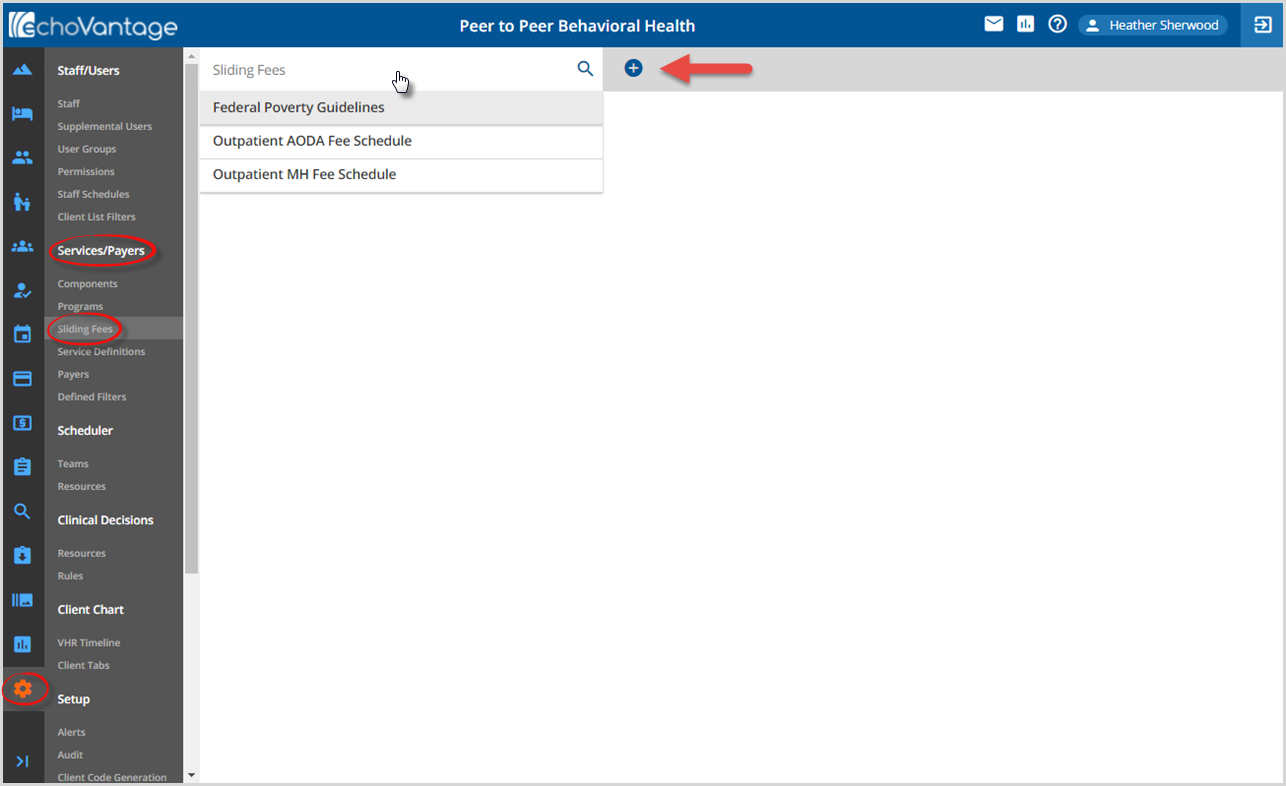
Use the Search box to locate existing Sliding Fees by entering the full or partial label name. Add a Sliding Fee by clicking on the blue plus "+". The following screen displays.
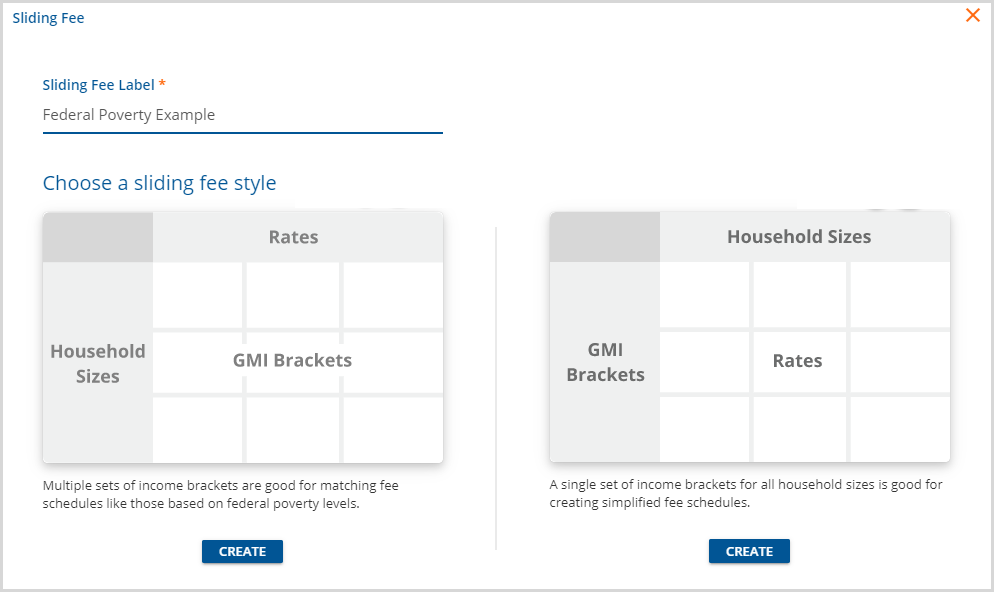
- When a Sliding Fee Label is entered, both blue CREATE buttons are enabled.
- Select CREATE under the fee schedule style that best meets your fee schedule requirements.
- The style cannot be changed once a Sliding Fee Schedule is created.
- To change the style, a new Sliding Fee Schedule, NOT a new version, must be created.
- The Sliding Fee style selected is stored in the database in dbo.SlidingFees.FormType.
- In the image above, the style on the left is FormType BY_RATE.
- In the image above, the style on the right is FormType BY_GMI.
Creating a Sliding Fee Schedule With Multiple Income Brackets (BY_RATE)
To create a Sliding Fee Schedule that uses multiple income brackets, like those based on Federal Poverty guidelines, choose the style on the left-hand side of the Add Sliding Fee screen. The following NEW VERSION screen displays.
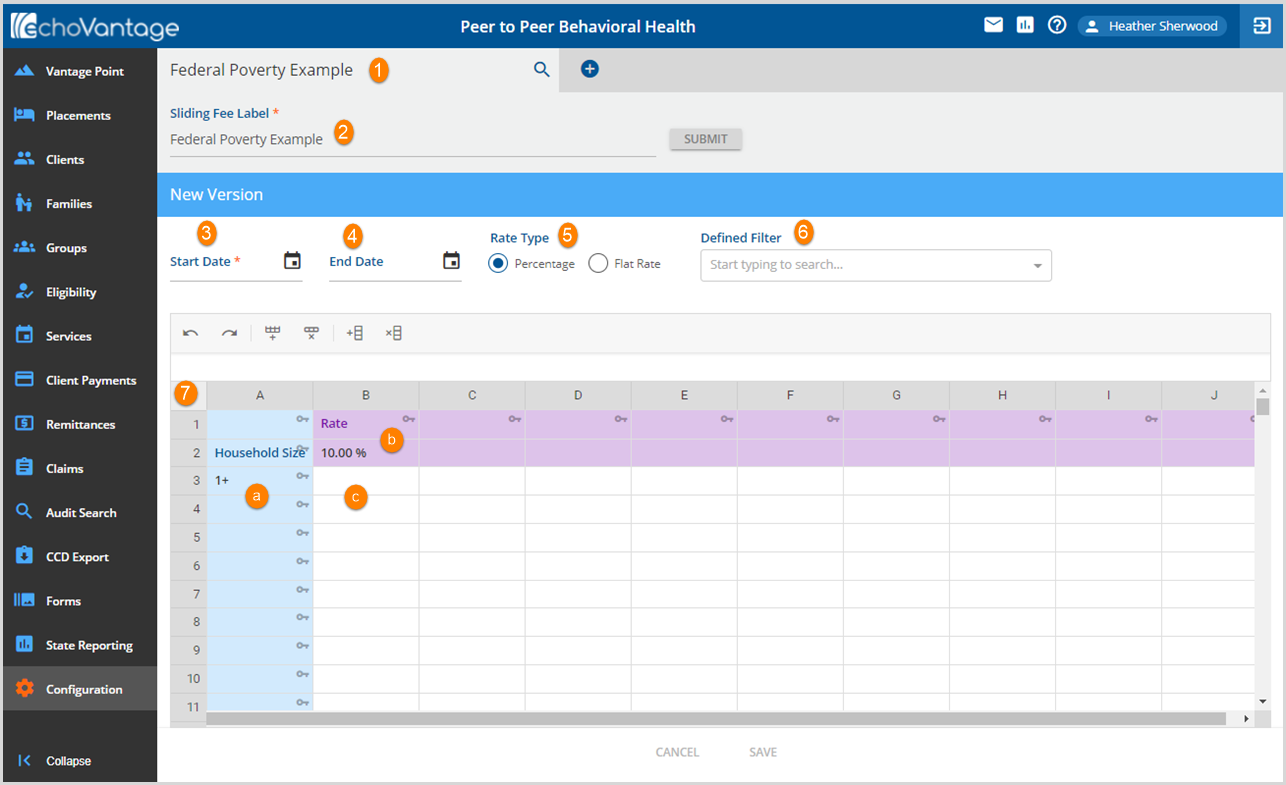
1. The current Sliding Fee Label displays in the search bar.
2. Sliding Fee Label - Use this field to edit the current Sliding Fee Label. The SUBMIT button enables when changes are made and must be selected to record the changes.
3. Start Date - Required for all Sliding Fee configurations. Start Date is the first date the Sliding Fee is active.
4. End Date - Not Required. End Date is the last date the Sliding Fee is active.
The Best Practice in maintaining Sliding Fee Schedules is to end-date the current Sliding Fee version and create a new version rather than just editing the current version. End-dating helps prevent errors during the billing process, especially for in-process services.
5. Rate Type - Required. Select either Percentage or Flat Rate for the Type. The application automatically formats the values entered in the spreadsheet section based on this selection.
6. Defined Filter - Not Required. Select a Defined Filter from the drop-down list to limit the Sliding Fee Schedule to specific Services, Components, or combination of Components.
7. The spreadsheet area defines the Sliding Fee table.
- (a) Household Size - blue shaded area.
- The application automatically populates this blue shaded column.
- Household Size row values increase by one as income amounts are entered in the unshaded area.
- A plus "+" sign is added to the last size listed when the cell below is blank.
- The default configuration allows up to 2000 Household Size rows.
- If a Household size is entered, the income for that row must be entered.
- Right-click on a row to bring up additional options like Add row, Remove row, Clear row, for example.
-
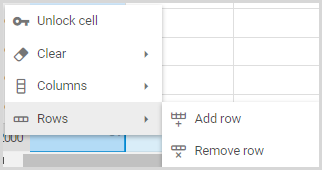
- (b) Rate - purple shaded area
- A default value of 10% or $10 displays in the first Rate column, this value can be edited.
- The rates must be manually entered for each column.
- If a column has a Rate value, each row beneath must have an income value, or an error is indicated when SAVE is selected.
- The default configuration allows up to 10 Rate columns.
- Right-click on a column to display additional options (Add, Remove, Edit Style, or Unlock).
- (c) Enter the maximum monthly income allowed values for the corresponding Household Size and Rate in the unshaded area.
Remember to select SAVE to retain the Sliding Fee configuration. This creates the first version associated with the Sliding Fee Label. Note that on SAVE, the application validates each row ensuring that the income entered in a cell is greater than the income amount entered in the cell immediately to the left. If the schedule fails validation, an error displays. Click on the error to view the spreadsheet areas needing correction.
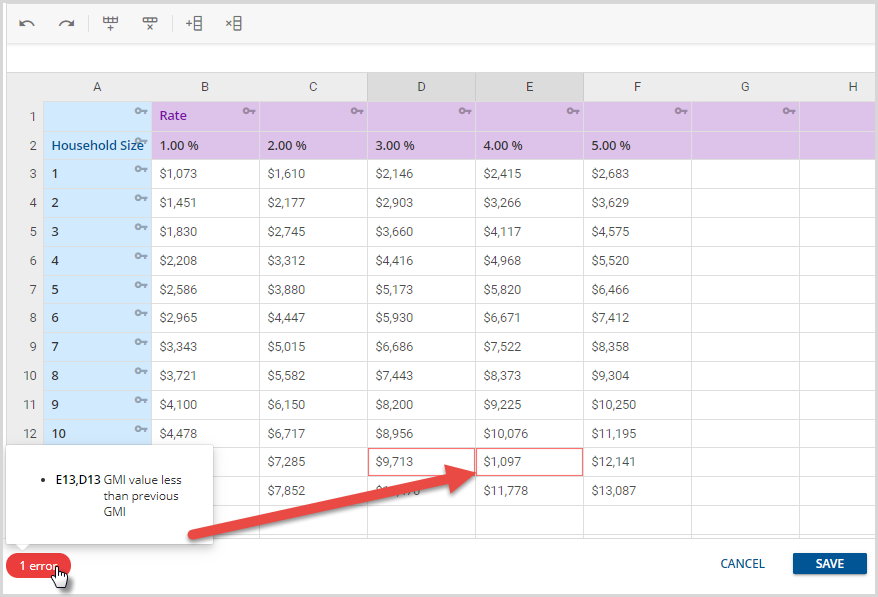
An example of a completed successfully saved Sliding Fee table is shown below.
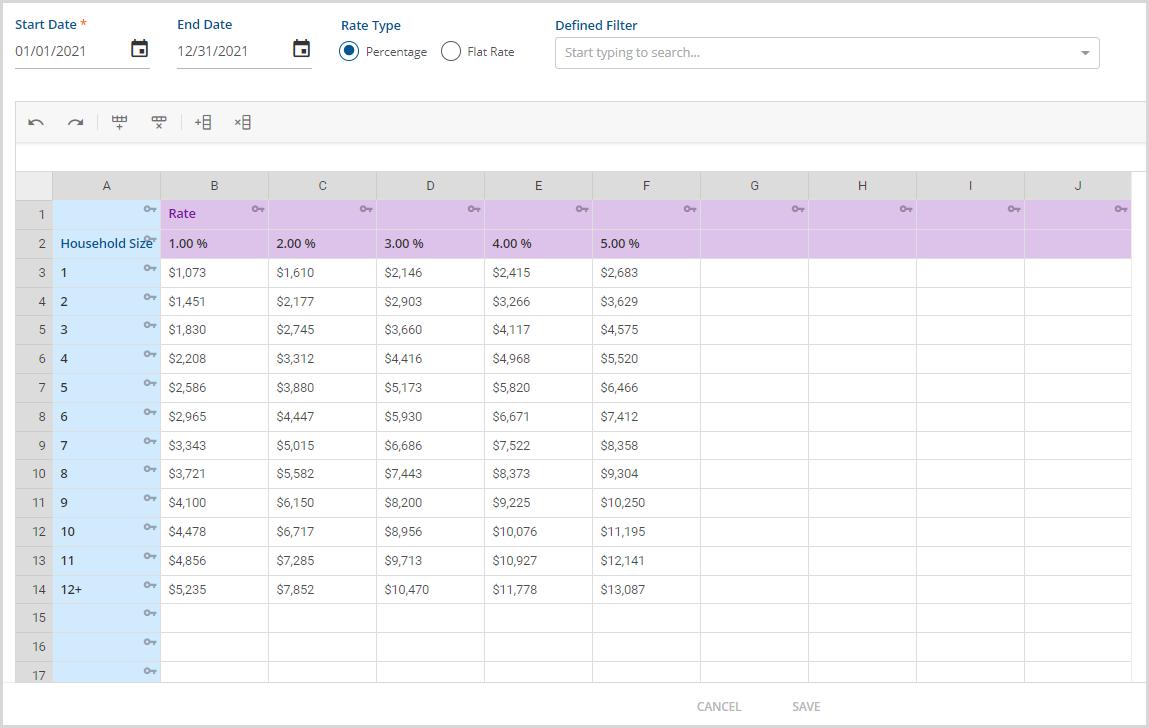
Creating a Simplified (BY_GMI) Sliding Fee Schedule
To create a Sliding Fee Schedule that uses a single set of income brackets for all household sizes, select the style on the right-hand side of the Add Sliding Fee screen. The following NEW VERSION screen displays.
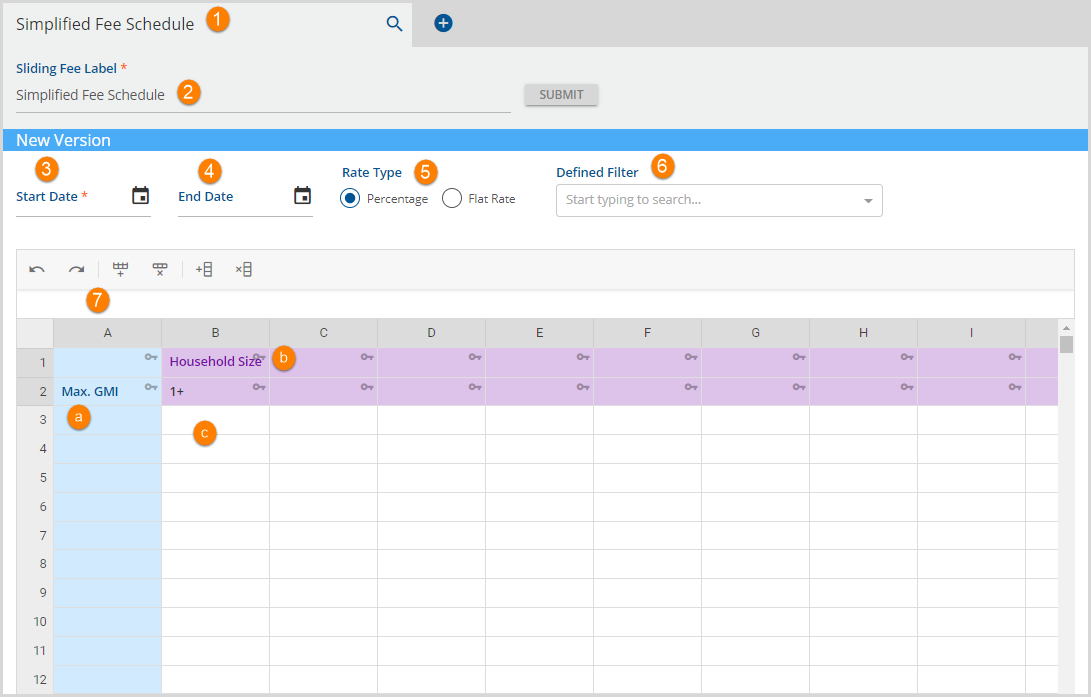
1. The current Sliding Fee Label displays in the search bar.
2. Use this field to edit an existing Sliding Fee Label. The SUBMIT button enables when changes are made and must be selected to record the changes.
3. The Start Date is required for all Sliding Fee configurations. This is the first date the Sliding Fee is active.
4. An End Date is not required. The End Date is the last date the Sliding Fee is active. Best Practice is to End Date the current Sliding Fee version and create a new version rather than just editing the current version. End dating helps to prevent errors during the billing process, especially for in-process services.
5. Select either Percentage or Flat Rate for the Type. The application will automatically format the values entered in the table based on this selection.
6. Select a Defined Filter if the Sliding Fee should be for specific Services, Components, or combination of Components.
7. The spreadsheet area defines the Sliding Fee table.
- Max. GMI - blue shaded area
- Enter the maximum monthly income value.
- These values are not automatically populated by the application.
- Household Size - purple shaded area
- The application automatically populates this purple header area.
- Household Size will increase by one as Rate amounts are entered in the column.
- A plus "+" sign is added to the last size when the next column is completely blank.
- Once a column is started, each row must have an entry.
- Enter the values for the Rate Type selected in the white area.
- Additional rows may be added by using the icons or right-clicking in a cell.
- Be sure to remove the automatically generated last row to avoid errors on SAVE.
Remember to select SAVE to retain the Sliding Fee configuration. This creates the first version.
Viewing an Existing Sliding Fee
Enter the full or partial Label Name in the search bar to find the desired fee schedule.
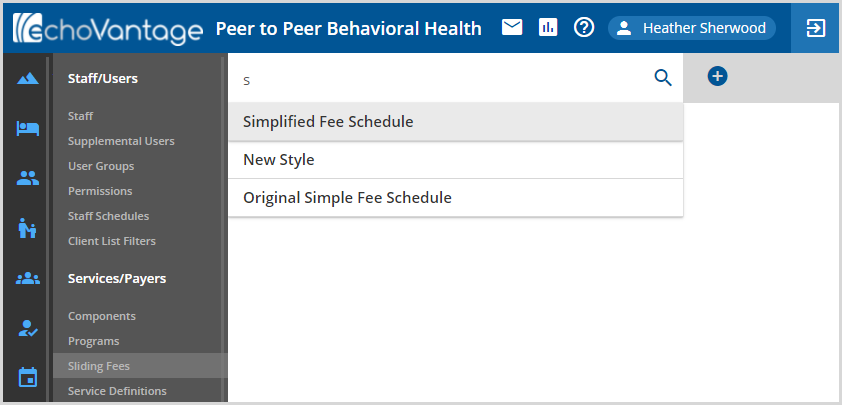
Make a selection from the search results list to view. The most recent version of the selected Sliding Fee, determined by Start Date, displays.
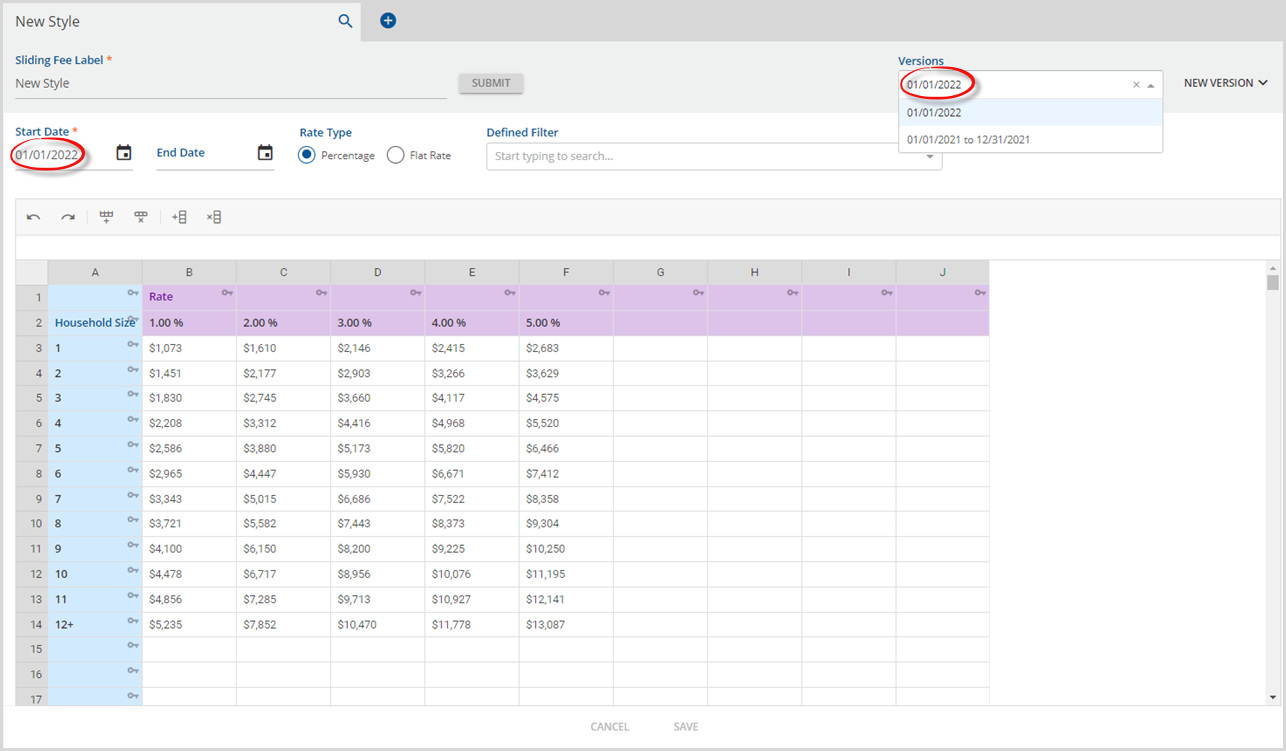
Use the Versions drop-down listing to find and select older versions to view. Versions are editable but changes to a rate schedule already in use can affect existing charges if they are reprocessed. To preserve historical records, the Best Practice is to end-date the current version and create a new version.
Adding a New Sliding Fee Version
Add a new version by selecting the "NEW VERSION" button in the top right-hand corner. The following options display.

- Copy Existing - When Copy Existing is selected, the screen switches to New Version mode with the Sliding Fee Label, Rate Type, Household Sizes, Rates, and Income information copied forward from the previously displayed version.
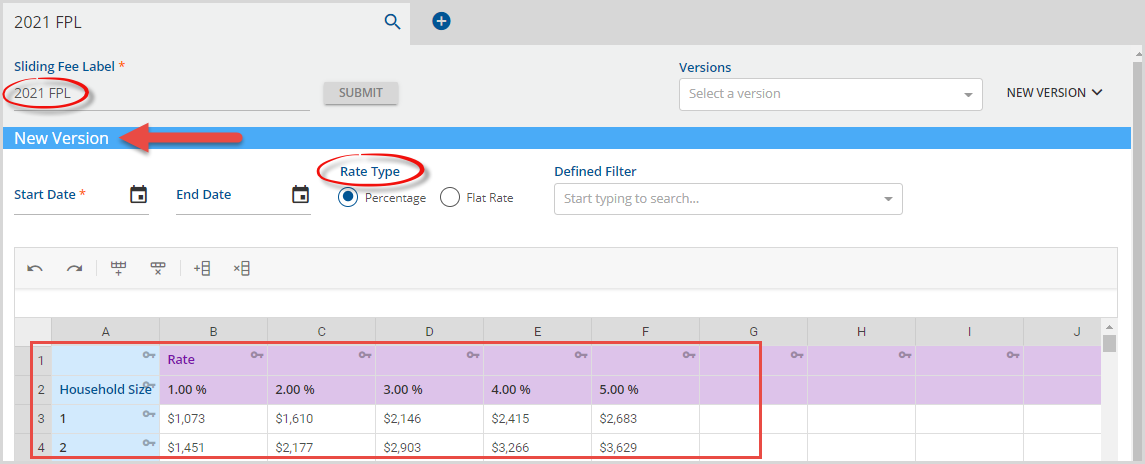
- If no version is displayed, the Copy Existing function is disabled.

- New Document - When New Document is selected, the screen switches to New Version mode in the same style as the existing sliding fee versions. The Sliding Fee Label and the default values for Rate Type, Household Size, and Rate if using the newer style (BY_RATE) are populated; no other information is carried forward.
